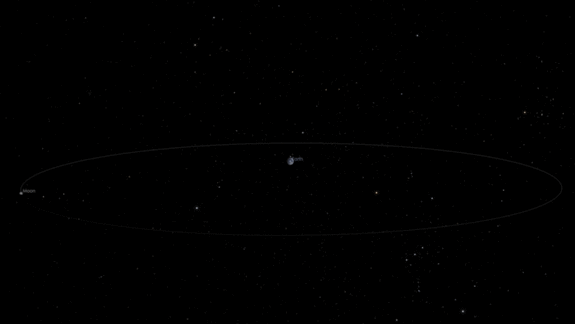Asteroid Skimming Past Earth Today May Loom Larger Than Exploding Russian Meteor
A newly discovered asteroid that will fly safely past Earth today (Feb. 9) may be larger than a celestial object that exploded over Chelyabinsk, Russia, five years ago. The newly found interloper, called 2018 CB, is estimated to be from 50 to 130 feet (15 to 40 meters) in diameter, and will fly by Earth at about 2:30 p.m. PST (5:30 p.m. EST).
"Asteroids of this size do not often approach this close to our planet — maybe only once or twice a year," said Paul Chodas, manager of the Center for Near-Earth Object Studies at NASA's Jet Propulsion Laboratory in California, in a statement from the agency.
2018 CB is a small asteroid by celestial standards; the largest asteroid in our solar system, Vesta, is roughly 326 miles (525 kilometers) across. (Dwarf planet Ceres is the largest object in the asteroid belt at 590 miles (950 km) across — roughly the size of Texas. It is sometimes referred to as an asteroid.)
But as residents of Chelyabinsk found out in 2013, something 2018 CB's size can cause a lot of damage. That year, an object roughly 17 m (51 feet) in diameter exploded above the town while hurtling through Earth's atmosphere, shattering glass and causing hundreds of injuries.
The NASA-funded Catalina Sky Survey spotted 2018 CB and another asteroid, 2018 CC, on Feb. 4. While 2018 CB isn't entering Earth's atmosphere, the object will whiz by safely at less than 20 percent of the distance from the Earth to the moon.
Coincidentally, 2018 CB's arrival comes just days after two other asteroids safely passed by Earth. On Super Bowl Sunday (Feb. 4), asteroid 2002 AJ129 came by the planet at a distance of only 2.6 million miles (4.2 million km) — 10 times the distance to the moon. (The average distance between the Earth and moon is about 238,855 miles, or 384,400 km.)
Then, on Tuesday (Feb. 6), asteroid 2018 CC made its closest approach, at 114,000 miles (184,000 km), roughly the halfway point between Earth and the moon. Astronomers, however, have known about this asteroid since 2002. It measures from 0.3 miles to 0.75 miles (0.5 to 1.2 km) across.
Get the world’s most fascinating discoveries delivered straight to your inbox.
Tracking asteroids
NASA and its Planetary Defense Coordination Office regularly search for and track asteroids using several partner telescopes. The goal is to catalog all near-Earth objects that could pose a threat to the planet. Right now, the agency hasn't announced the detection of any imminent threats. It publishes all its asteroid findings online at the Small-Body Database Browser, which is freely available online.
There are also several asteroid missions in space that are ongoing, or coming up soon, designed to gain more information about how asteroids are formed and where they are located.
NASA's dedicated asteroid-hunting telescope, NEOWISE, will conclude its mission this year when its orbit brings the insturment into a zone with too much sunlight for observations. The agency's OSIRIS-ReX — and Japan's Hayabusa 2 — are on their way to different asteroids to pick up samples for later analysis back at Earth. Two new NASA missions, called Lucy and Psyche, will fly past eight asteroids in the 2020s and 2030s.
NASA is in an ongoing quest to catalog 90 percent of asteroids that are larger than 140 m (460 feet) wide and that will come to within about 4.65 million miles (7.48 million km) of Earth, or about 20 times the distance from Earth to the moon, according to the agency. In 2005, Congress tasked NASA with completing this work by 2020, but multiple reports suggest that the agency will miss that deadline. NASA did, however, meet Congress' goal of finding 90 percent of all Near Earth Objects (NEO's) that are 1 km (0.6 miles wide) in 2010.
Follow us @Spacedotcom, Facebook and Google+. Original article on Space.com.

Elizabeth Howell was staff reporter at Space.com between 2022 and 2024 and a regular contributor to Live Science and Space.com between 2012 and 2022. Elizabeth's reporting includes multiple exclusives with the White House, speaking several times with the International Space Station, witnessing five human spaceflight launches on two continents, flying parabolic, working inside a spacesuit, and participating in a simulated Mars mission. Her latest book, "Why Am I Taller?" (ECW Press, 2022) is co-written with astronaut Dave Williams.




